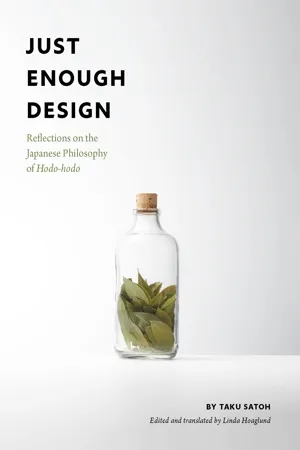
Just Enough Design
Reflections on the Japanese Philosophy of Hodo-hodo
- 144 pages
- English
- ePUB (mobile friendly)
- Available on iOS & Android
About this book
A Japanese designer offers a compelling alternative way to engage with our possessions, our history, our environment, and each other. The Japanese phrase " hodo-hodo" originates in ancient times. When contemporary designer Taku Satoh applies it to his work, it means "just enough." Hodo-hodo design deliberately holds back, leaving room for individuals to engage with objects according to their unique sensibilities. In the midst of a consumerist age, Satoh has built an illustrious design career around this philosophy, creating iconic work in fashion, food, and architecture. His ideas speak not just to professional designers, but to anyone who wishes to move more thoughtfully through the world. Within this slim but powerful volume, Satoh explains his philosophy through tangible examples—from the aesthetic of a timeworn ramen shop to a rooftop playground inspired by onomatopoeia. Urging readers to appreciate everyday objects and spaces and to question the lure of convenience, he delivers a message rooted in the past yet perfectly suited to our times. TIMELY TOPIC: As more people begin to question the structures of consumerism, this thoughtful book offers a different way of seeing the world. Satoh's philosophy aligns perfectly with sustainable lifestyles. UNIQUE INSIGHTS INTO JAPANESE CULTURE: Japan is a huge cultural exporter and a booming travel destination. Many Japanese ideas and traditions—such as ikigai, forest bathing, and wabi-sabi—are being widely celebrated as pathways to a more fulfilling life. This book presents hodo-hodo, a concept not yet widely exported. Learning about hodo-hodo will enrich readers' understanding of Japan, as well as inspire designers and other creatives in their work. AUTHORITATIVE VOICE: Taku Satoh has over four decades of design experience. His work is renowned in Japan, and he's worked with major brands and museums and won many awards. Here, he shares wisdom drawn from his design expertise and his deep love for his culture. ACCESSIBLE CONTENT: The handy paperback format is perfect for a book that you will want to read and re-read. Satoh proposes fascinating and pertinent ideas in an unintimidating way. Perfect for:
- Designers and design students
- Creatives of all kinds
- Readers passionate about sustainability
Anyone interested in Japanese culture and history
Frequently asked questions
- Essential is ideal for learners and professionals who enjoy exploring a wide range of subjects. Access the Essential Library with 800,000+ trusted titles and best-sellers across business, personal growth, and the humanities. Includes unlimited reading time and Standard Read Aloud voice.
- Complete: Perfect for advanced learners and researchers needing full, unrestricted access. Unlock 1.4M+ books across hundreds of subjects, including academic and specialized titles. The Complete Plan also includes advanced features like Premium Read Aloud and Research Assistant.
Please note we cannot support devices running on iOS 13 and Android 7 or earlier. Learn more about using the app.
Information
Table of contents
- Cover
- Half Title
- Title Page
- Dedication
- Copyright
- Contents
- Introduction
- Hodo-hodo no Dezain: Just Enough Design
- Designing the User Experience: Nikka Whisky Pure Malt (1984)
- Design Is Everywhere
- Design and Ramen
- To Design or Not to Design
- Question the Obvious: Max Factor fec. (1986)
- Supple Thinking
- Do Designers Require Taste?
- Wooden Stones: (2010)
- Everything Is Designed
- Mizkan’s 210th Anniversary Project: (2013)
- Thoughtfulness
- Designing for Television: (2003– )
- A Rooftop of Onomatopoeia: (2017)
- Designing Terroir: The Sundried Sweet Potato School (2007)
- Designing Basics: (2005)
- Designing for Artists
- What We Lose to Convenience: (1989)
- The Convenience Virus
- A Little Spirit: (1985)
- Value Added
- Packaging Designed for Memories: (2000)
- Structure and Surface
- A Japanese Design: (2005)
- Surfing
- Always a Graphic Designer
- Glossary
- Image Credits
- About the Author and Translator